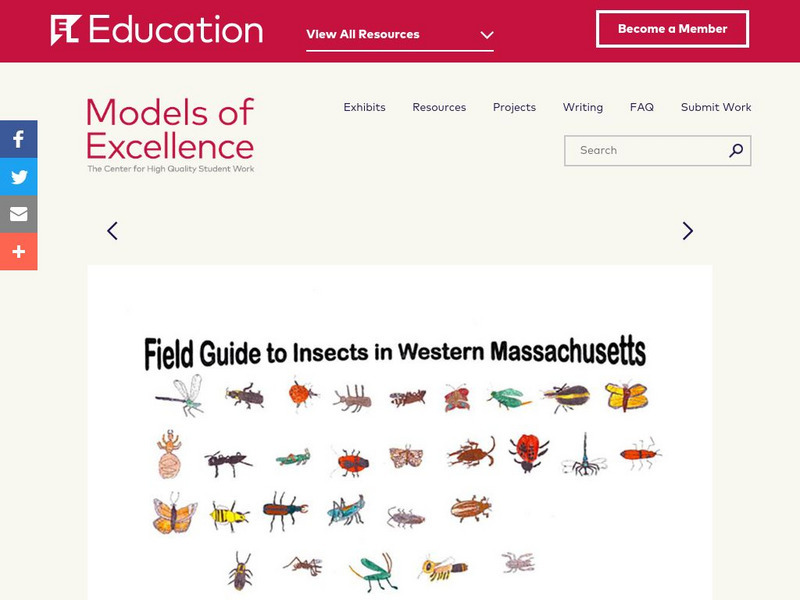Curated OER
Spring Collecting and Identifying Bumble Bees
Learners collect bumble bees in the field, record data, identify and release specimens, answer conclusion questions, and send data in to researcher leaders. They make research based conclusions based upon the evidence.
Curated OER
Project Design
Twelfth graders study Thoreau as "philosopher" and developing a personal philosophy of life (both metaphorically and literally). They come to an understanding of the interconnectedness of the natural world. Students come to a realization...
Curated OER
Virginia Studies
Students describe life in the Virginia colony. They explain how geography influenced the relocation of Virginia's capital from Jamestown to Williamsburg, to Richmond. Students compare/contrast life in Jamestown and Williamsburg.
Curated OER
Mallard's Wet Olympics
Pupils investigate some of the different characteristics of living things. They make observations from reading and interactive media. Students observe that animals move in different ways and have adaptations to aid in that action.
Curated OER
Bat Facts
Student's demonstrate an understanding of basic facts about bats by creating a picture representation of bats in their habitat describing information they learned. The lesson is especially favorable for visual learners.
Curated OER
Exploring Bats
Third graders create a graphic organizer about bats in cooperative groups. The graphic organizer is used to illustrate the information that has been researched. The specific graphic organizer is the KWL.
Curated OER
A World of Feathered Friends
students will learn to
respect the nature around them. This respect is vital because ignorance of surrounding
nature can lead to carelessness when curiosity goes awry. A perfect example of this
wayward curiosity took place at our school...
Curated OER
Foods for Better Health
Students define biotechnology and discuss the economic impact of biotechnology. They also describe what a 1015 onion and a slow-softening tomato are and how they are produced. They examine the safety of genetically-engineered or altered...
Curated OER
COLORS ON THE FARM
Students follow directions regarding what colors farm objects should be
colored. They identify various items pictured on provided worksheet that can be found on a farm or are made from farm animals. Finally, they match each color crayon...
Curated OER
LISTENING TO DIRECTIONS
Students view farm objects or products made from farm animals and follow the oral instructions given by the teacher. They are given worksheets, there are three sets of directions for the one worksheet. Students worksheets have everything...
Curated OER
The Lepidoptera Project
Young scholars are introduced to Scientific Inquiry and discover how to design an experiment that answers critical questions using butterflies as the topic. They design experiments that compare the number of species of butterflies in a...
Curated OER
Escape From the Antlion's Pit
Students draw conclusions about the effectiveness of antlion's pits in catching prey. A brief review of the antlion and its hunting habits is conducted. After watching a video about the use of pits to catch prey, students complete a...
Curated OER
Antlion Pit Building Investigation
Students design and perform an experiment related to comparing and contrasting antlion pits. Given a set of parameters, students select a hypothesis and perform observations on antlion pits. They record data and use this date to support...
Curated OER
Malaria: The Cause
Students explore the basic facts about malaria. They study how the disease can spread so quickly and label the pathway of the malaria parasite.
Curated OER
Birds of Wisconsin
First graders explore the job done by ornithologists. They role play identifying the characteristics that make a bird a bird. They discuss what makes each bird species unique. Students are introduced to Wisconsin's most common and rare...
Curated OER
Ecosystems and Symbiotic Relationships
Students are told to create a community using words or pictures. They walk outside to an area in front of the school which has a strip of grass, ditch, and corn field. Students discuss the difference between an ecosystem and a...
Curated OER
Chemicals in Your Life
In this chemicals learning exercise, students fill in 61 blanks of statements comparing the chemicals used in farming and the chemicals found in medicines and food.
Curated OER
Crossword
For this crossword worksheet that focuses on natural disasters, students find the vertical word in the colored squares by filling in the right words in ten lines in the horizontal boxes. Answers appear at the bottom of the worksheet.
Curated OER
Explorit's Biology Quiz
In this biology worksheet, students complete a five question multiple choice on-line interactive quiz about animal and plant biology.
Curated OER
Science in Your Shopping Cart
Learners research the use of science in food production in the United States. In this science and food lesson, students visit a specific website to learn about the science used in various food products for United States consumption.
Curated OER
Crickets on the Hearth
Students investigate how crickets behave in cold temperatures. For this life science lesson, students explain the beneficial and harmful effect of pests. They research ways to properly manage them.
Cynthia J. O'Hora
Mrs. O's House: Select and Insect Mascot for School or Community
Based on a scenario given, learners will work to nominate an insect mascot for the school or the community for an upcoming event. Students will conduct research through resources provided or their own, create a presentation, and vote for...
EL Education
El Education: Field Guide to Insects in Western Massachusetts
This field guide was created by 2nd graders in Springfield, Massachusetts. It was part of a two-month Learning Expedition that included field observation and collection, classroom experimentation and research, reading from books and...
Science Education Resource Center at Carleton College
Serc: Investigating Insects in Nature
In this lab, learners will collect insects while making close observations of living things. They will then classify insects into seven common groups based on characteristics discussed in the classroom.

























